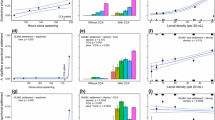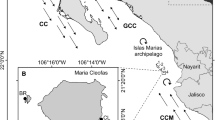Abstract
Space availability is a key factor linked to the settlement success of marine invertebrates. Settlement space on coral reefs is predicted to become increasingly fragmented and occupied by competitors under future disturbance regimes, yet how this impacts coral settlement remains largely unknown. We test the effects of space limitation on larval settlement in three common Indo-Pacific corals (Acropora valida, Acropora digitifera and Anacropora spinosa) by manipulating substrate area while maintaining a constant larval supply. Settlement success was highly variable among coral species, with reduced space leading to an up to four-fold increase in settlement of A. valida larvae, a two-fold decrease in settlement of An. spinosa larvae and no significant effect for A. digitifera. All species displayed similar spatial settlement patterns, whereby larvae settled gregariously irrespective of how much space was available. At the same time, settlers were found to increasingly occur in aggregates (in direct contact with each other) as space decreased. We propose that increased settler aggregations, coupled with settlement intensification for some species, facilitates the formation of chimeras as space becomes limiting. In colonial organisms, the formation of aggregates and particularly chimeric individuals may offset the negative effects of increased competition for space by allowing settlers to rapidly exceed size-escape thresholds, thereby increasing the likelihood of survival.


Similar content being viewed by others
References
Aguirre JD, Miller SH, Morgan SG, Marshall DJ (2013) Relatedness affects the density, distribution and phenotype of colonisers in four sessile marine invertebrates. Oikos 122:881–888
Amar KO, Chadwick NE, Rinkevich B (2008) Coral kin aggregations exhibit mixed allogeneic reactions and enhanced fitness during early ontogeny. BMC Evol Biol 8
Barki Y, Gateno D, Graur D, Rinkevich B (2002) Soft-coral natural chimerism: a window in ontogeny allows the creation of entities comprised of incongruous parts. Marine Ecology-Progress Series 231:91–99
Bertness MD, Gaines SD, Stephens EG, Yund PO (1992) Components of recruitment in populations of the acorn barnacle Semibalanus balanoides (Linnaeus) J Exp Mar Biol Ecol 156:199-215
Birkeland C, Rowley D, Randall RH (1981) Coral Recruitment Patterns at Guam. Proceedings of the 4th International Coral Reef Symposium 2:339-344
Box SJ, Mumby PJ (2007) Effect of macroalgal competition on growth and survival of juvenile Caribbean corals. Marine Ecology-Progress Series 342:139–149
Christiansen NA, Ward S, Harii S, Tibbetts IR (2009) Grazing by a small fish affects the early stages of a post-settlement stony coral. Coral Reefs 28:47–51
Connell JH (1978) Diversity in tropical rain forests and coral reefs - high diversity of trees and corals is maintained only in a non-equilibrium state. Science 199:1302–1310
Connell JH (1985) The Consequences of Variation in Initial Settlement Vs Postsettlement Mortality in Rocky Intertidal Communities. J Exp Mar Biol Ecol 93:11–45
dela Cruz DW, Harrison PL (2017) Enhanced larval supply and recruitment can replenish reef corals on degraded reefs. Scientific Reports 7
Dixon DL, Abrego D, Hay ME (2014) Chemically mediated behavior of recruiting corals and fishes: A tipping point that may limit reef recovery. Science 345:892–897
Doropoulos C, Gomez-Lemos LA, Babcock RC (2018) Exploring variable patterns of density-dependent larval settlement among corals with distinct and shared functional traits. Coral Reefs 37:25–29
Doropoulos C, Evensen NR, Gomez-Lemos LA, Babcock RC (2017) Density-dependent coral recruitment displays divergent responses during distinct early life-history stages. Royal Society Open Science 4
Doropoulos C, Ward S, Roff G, Gonzalez-Rivero M, Mumby PJ (2015) Linking Demographic Processes of Juvenile Corals to Benthic Recovery Trajectories in Two Common Reef Habitats. PLoS ONE 10
Doropoulos C, Roff G, Bozec YM, Zupan M, Werminghausen J, Mumby PJ (2016) Characterizing the ecological trade-offs throughout the early ontogeny of coral recruitment. Ecol Monogr 86:20–44
Duerden JE (1902) Aggregated colonies in madreporarian, corals. Am Nat 36:461–471
Edwards AJ, Guest JR, Heyward AJ, Villanueva RD, Baria MV, Bollozos ISF, Golbuu Y (2015) Direct seeding of mass-cultured coral larvae is not an effective option for reef rehabilitation. Mar Ecol Prog Ser 525:105–116
Elmer F, Bell JJ, Gardner JPA (2018) Coral larvae change their settlement preference for crustose coralline algae dependent on availability of bare space. Coral Reefs 37:397–407
Fairfull SJL, Harriott VJ (1999) Succession, space and coral recruitment in a subtropical fouling community. Mar Freshw Res 50:235–242
Ferrari R, Gonzalez M, Mumby PJ (2012) Size matters in the competition between corals and macroalgae. Mar Ecol Prog Ser 467:77–88
Frank U, Oren U, Loya Y, Rinkevich B (1997a) Alloimmune maturation in the coral Stylophora pistillata is achieved through three distinctive stages, 4 months post-metamorphosis. Proceedings of the Royal Society B-Biological Sciences 264:99–104
Frank U, Oren U, Loya Y, Rinkevich B (1997b) Alloimmune maturation in the coral Stylophora pistillata is achieved through three distinctive stages, 4 months post-metamorphosis. Proceedings of the Royal Society of London Series B-Biological Sciences 264:99–104
Gaines S, Roughgarden J (1985) Larval Settlement Rate - a Leading Determinant of Structure in an Ecological Community of the Marine Intertidal Zone. Proc Natl Acad Sci U S A 82:3707–3711
Gilmour JP, Smith LD, Heyward AJ, Baird AH, Pratchett MS (2013) Recovery of an Isolated Coral Reef System Following Severe Disturbance. Science 340:69–71
Graham NAJ, Wilson SK, Jennings S, Polunin NVC, Bijoux JP, Robinson J (2006) Dynamic fragility of oceanic coral reef ecosystems. Proc Natl Acad Sci U S A 103:8425–8429
Harrigan JF (1972) Behavior of planula larva of scleractinian coral Pocillopora damicornis (L). Am Zool 12:723
Harrington L, Fabricius K, De’Ath G, Negri A (2004) Recognition and selection of settlement substrata determine post-settlement survival in corals. Ecology 85:3428–3437
Heyward AJ, Smith LD, Rees M, Field SN (2002) Enhancement of coral recruitment by in situ mass culture of coral larvae. Marine Ecology-Progress Series 230:113–118
Hughes TP, Anderson KD, Connolly SR, Heron SF, Kerry JT, Lough JM, Baird AH, Baum JK, Berumen ML, Bridge TC, Claar DC, Eakin CM, Gilmour JP, Graham NAJ, Harrison H, Hobbs JPA, Hoey AS, Hoogenboom M, Lowe RJ, McCulloch MT, Pandolfi JM, Pratchett M, Schoepf V, Torda G, Wilson SK (2018) Spatial and temporal patterns of mass bleaching of corals in the Anthropocene. Science 359:80-+
Jones GP, Almany GR, Russ GR, Sale PF, Steneck RS, van Oppen MJH, Willis BL (2009) Larval retention and connectivity among populations of corals and reef fishes: history, advances and challenges. Coral Reefs 28:307–325
Kohler KE, Gill SM (2006) Coral Point Count with Excel extensions (CPCe): A Visual Basic program for the determination of coral and substrate coverage using random point count methodology. Comput Geosci 32:1259–1269
Kuffner IB, Walters LJ, Becerro MA, Paul VJ, Ritson-Williams R, Beach KS (2006) Inhibition of coral recruitment by macroalgae and cyanobacteria. Marine Ecology-Progress Series 323:107–117
Lewis JB (1974) Settlement behaviour of planulae larvae of hermatypic coral Favia fragum (Esper). J Exp Mar Biol Ecol 15:165–172
Lukoschek V, Cross P, Torda G, Zimmerman R, Willis BL (2013) The Importance of Coral Larval Recruitment for the Recovery of Reefs Impacted by Cyclone Yasi in the Central Great Barrier Reef. PLoS ONE 8
Minchinton TE, Scheibling RE (1993) Free-Space Availability and Larval Substratum Selection as Determinants of Barnacle Population-Structure in a Developing Rocky Intertidal Community. Mar Ecol Prog Ser 95:233–244
Norstrom AV, Nystrom M, Lokrantz J, Folke C (2009) Alternative states on coral reefs: beyond coral-macroalgal phase shifts. Marine Ecology-Progress Series 376:295–306
Pandolfi JM, Connolly SR, Marshall DJ, Cohen AL (2011) Projecting coral reef futures under global warming and ocean acidification. Science 333:418–422
Pandolfi JM, Bradbury RH, Sala E, Hughes TP, Bjorndal KA, Cooke RG, McArdle D, McClenachan L, Newman MJH, Paredes G, Warner RR, Jackson JBC (2003) Global trajectories of the long-term decline of coral reef ecosystems. Science 301:955–958
Pawlik JR (1992) Chemical Ecology of the Settlement of Benthic Marine-Invertebrates. Oceanography and Marine Biology 30:273–335
Pineda J (1994) Spatial and Temporal Patterns in Barnacle Settlement Rate Along a Southern California Rocky Shore. Mar Ecol Prog Ser 107:125–138
Pineda J, Caswell H (1997) Dependence of settlement rate on suitable substrate area. Marine Biology 129:541–548
Pineda J, Porri F, Starczak V, Blythe J (2010) Causes of decoupling between larval supply and settlement and consequences for understanding recruitment and population connectivity. J Exp Mar Biol Ecol 392:9–21
Price N (2010) Habitat selection, facilitation, and biotic settlement cues affect distribution and performance of coral recruits in French Polynesia. Oecologia 163:747–758
Puill-Stephan E, Willis BL, van Herwerden L, van Oppen MJH (2009) Chimerism in Wild Adult Populations of the Broadcast Spawning Coral Acropora millepora on the Great Barrier Reef. PLoS ONE 4
Puill-Stephan E, van Oppen MJH, Pichavant-Rafini K, Willis BL (2012a) High potential for formation and persistence of chimeras following aggregated larval settlement in the broadcast spawning coral, Acropora millepora. Proceedings of the Royal Society B-Biological Sciences 279:699–708
Puill-Stephan E, Willis BL, Abrego D, Raina JB, van Oppen MJH (2012b) Allorecognition maturation in the broadcast-spawning coral Acropora millepora. Coral Reefs 31:1019–1028
R Core Team (2019) A language and environment for statistical computing. In: Computing. RFfS (ed), Vienna, Austria
Randall CJ, Szmant AM (2009) Elevated temperature reduces survivorship and settlement of the larvae of the Caribbean scleractinian coral, Favia fragum (Esper). Coral Reefs 28:537–545
Raymundo LJ, Maypa AP (2004) Getting bigger faster: Mediation of size-specific mortality via fusion in juvenile coral transplants. Ecol Appl 14:281–295
Rinkevich B (2004) Allorecognition and xenorecognition in reef corals: a decade of interactions:443-450
Roff G, Mumby PJ (2012) Global disparity in the resilience of coral reefs. Trends Ecol Evol 27:404–413
Roughgarden J, Iwasa Y, Baxter C (1985) Demographic-Theory for an Open Marine Population with Space-Limited Recruitment. Ecology 66:54–67
Sammarco PW (1982) Echinoid grazing as a structuring force in coral communities - whole reef manipulations. J Exp Mar Biol Ecol 61:31–55
Suzuki G, Arakaki S, Suzuki K, Iehisa Y, Hayashibara T (2012) What is the optimal density of larval seeding in Acropora corals? Fisheries Science 78:801–808
Vermeij MJA (2005) Substrate composition and adult distribution determine recruitment patterns in a Caribbean brooding coral. Mar Ecol Prog Ser 295:123–133
Vermeij MJA, Sandin SA (2008) Density-dependent settlement and mortality structure the earliest life phases of a coral population. Ecology 89:1994–2004
Wickham H (2009) ggplot2: Elegant graphics for data analysis. Springer, New York
Funding
Funding was provided by the Westpac Scholars (Westpac Future Leaders Scholarship to C. Sims), Centre of Excellence for Coral Reef Studies (Australian Research Council Grant No. CE140100020 to J. Pandolfi and others) and The University of Queensland (Research Station Grants Scheme to E. Sampayo and J. Pandolfi).
Author information
Authors and Affiliations
Corresponding author
Ethics declarations
Conflict of interest
On behalf of all authors, the corresponding author states that there is no conflict of interest.
Additional information
Topic Editor Anastazia Banaszak
Publisher's Note
Springer Nature remains neutral with regard to jurisdictional claims in published maps and institutional affiliations.
Electronic supplementary material
Below is the link to the electronic supplementary material.
Rights and permissions
About this article
Cite this article
Sampayo, E.M., Roff, G., Sims, C.A. et al. Patch size drives settlement success and spatial distribution of coral larvae under space limitation. Coral Reefs 39, 387–396 (2020). https://doi.org/10.1007/s00338-020-01901-1
Received:
Accepted:
Published:
Issue Date:
DOI: https://doi.org/10.1007/s00338-020-01901-1




